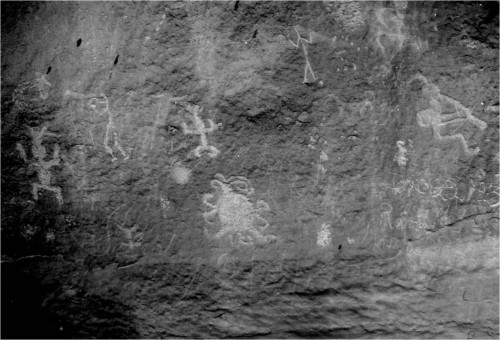
Ancient eclipse: a Chaco Canyon petroglyph (Courtesy: University of Colorado)
By Sarah Tesh, Matin Durrani and Michael Banks
The approaching total solar eclipse on 21 August is the subject of much interest and excitement — but the Earth has of course been in and out of the Moon’s shadow since it formed. While we have the technology to take spectacular photos of the corona framing the Moon, our ancestors were limited to much cruder means of recording such events. For example, the ancient petroglyph (a carving in rock) shown above may represent a total eclipse that occurred in 1097. The carving is on a free standing rock known Piedra del Sol in New Mexico’s Chaco Canyon. “I think it is quite possible that the Chacoan people may have congregated around Piedra del Sol at certain times of the year and were watching the sun move away from the summer solstice when the eclipse occurred,” says solar physicist J. McKim Malville from the University of Colorado, Boulder in the US, who focuses on archaeoastronomy. Other nearby carvings may be related to the 1054 supernova and the passing of Halley’s Comet in 1066. “The appearance of the spectacular supernova and comet may have alerted the residents of the canyon to pay attention to powerful and meaningful events in the sky,” says Malville. Hopefully our records of astronomical events will be as long lasting as those of the Chacoan people.
They say asteroids crashing into the Earth is one scientific topic you can guarantee will always make it into the mainstream media. And so it proved this week, with plenty of coverage of asteroid 2012 TC4, which will pass close to Earth on 12 October this year. Quite why this story made it onto various news outlets, from the Guardian and the Daily Mail to MSN News and the Telegraph isn’t quite clear. That’s because the asteroid, which is about 15-30 metres long, will “zoom harmlessly” at a distance of about 44,000km past the Earth, according to a press release from Agence France-Presse (AFP). As Detlef Koschny from the European Space Agency’s near-Earth bojects team told AFP: “There is no possibility for this object to hit the Earth”. The asteroid’s trajectory is a close miss for sure – the farthest satellites are 36,000 km from our planet – but we’re scratching our heads why this rocky body’s trajectory is has made it into the news two months before it flies by. I guess people just love click-bait scare stories. Look at us, even we’ve been snared. And so, now, have you.
“It’s absolutely shameful for them to use my name in their marketing campaign without my permission,” proclaimed the Nobel laureate Andre Geim from the University of Manchester. For the past two years Geim, who recently said that he could leave the UK because of Brexit, has been the face of a Chinese underwear company that claims to have incorporated graphene into its products. The firm, Shenquan, says that by putting graphene into its garments it can help them retain heat, eliminate odours, kill bacteria and even improve sexual performance. “I was told that because the material is ‘very black’ it retains heat better. I pointed out that this contradicted basic science because dark surfaces emit heat better, not retain it,” Geim told the South China Morning Post. “After this remark, the company gave me boxers and a pair of socks to try for myself to see how it works … I never put them on because their textile felt low quality and uncomfortable, at least in 2015.” Ouch.
Guidelines
Show/hide formatting guidelines
this text was deletedwhere people live in harmony with nature and animals</q>
Some text